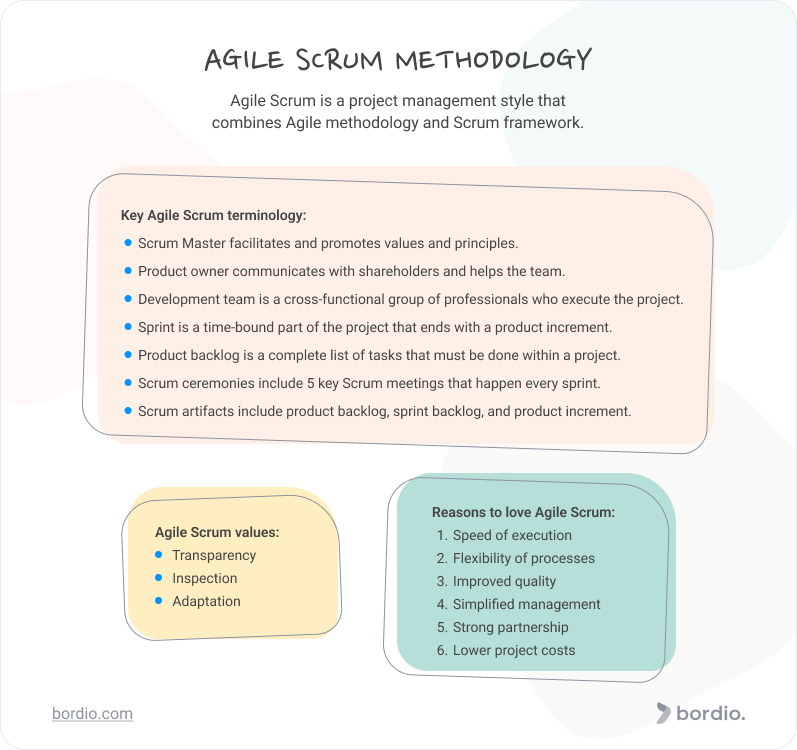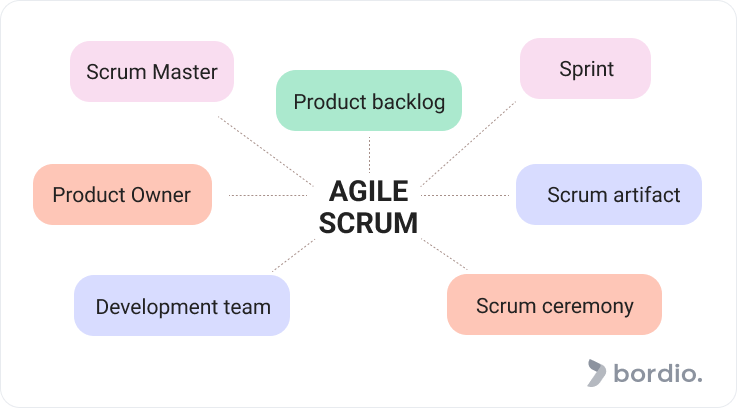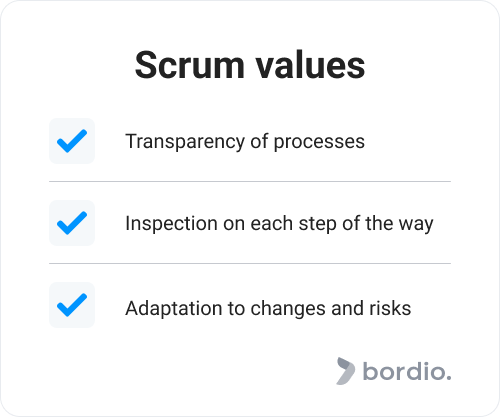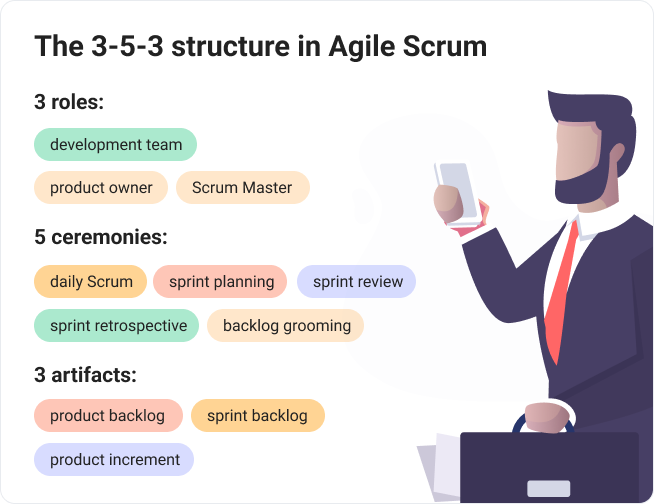Agile is a project management methodology that celebrates change, flexibility, small-scale iterations, and continuous learning.
Scrum is a project management framework that offers principles, actionable guidelines, and techniques to support the Agile methodology.
Scrum is traditionally considered a part of Agile methodology and the two terms are sometimes used interchangeably.
Scrum is always Agile but Agile is not always Scrum. The Agile methodology also works with frameworks like Kanban, Lean, Extreme Programming, and others.
Also, Agile Scrum is mostly used in software development, whereas other Agile frameworks can be applied to other product and services creations.
Agile and Scrum can be used separately but together their benefits multiply and deliver that much more value to the project teams. You can use these techniques along with team organization software increasing your productivity. And for teams working remotely, you can use remote collaboration solutions.
Today we will dive deep into Agile Scrum project management, see how it works and learn why it became so popular.
Agile Scrum terminology
Before we go into details though, let’s cover some of the key terminologies that everyone needs to understand if they want to use Agile Scrum for managing software development projects.
- Scrum Master is a servant leader. They facilitate an Agile mindset and promote Scrum frameworks through guidance and assistance in meetings and during the project.
- The product owner is a communicator between stakeholders and the team. They understand the vision and challenges of business, and they use their knowledge to assist the development team with project execution. Remember that the product owner does NOT equal the project manager.
- A development team is a group of professionals who is actively working on the project. The development team is self-organized, everyone shares the responsibility for the end result and strives to improve continuously.
- Sprint is a one to four-week period of time during which the Scrum team delivers a product increment, also known as a potentially shippable product, which can be used by the business user.
- The product backlog is a prioritized list of user stories (requirements) that the team works through during the project.
- Scrum ceremonies are 5 key Scrum meetings that support the Agile software development process. Each meeting serves a different purpose and is held at a certain time within the sprint. The 5 ceremonies are daily stand-up (a.k.a. daily Scrum), sprint planning, sprint review, sprint retrospective, and backlog refinement (or backlog grooming).
- Scrum artifacts are elements of the Scrum framework that provide structure and help teams stay on track with the project. The by-the-book artifacts are product backlog, sprint backlog, and product increment. Additional artifacts are a burnup chart, a burndown chart, and a sprint plan. Check out the Scrum artifacts expert article for more details.
Agile Scrum beliefs
Key priorities of Agile Scrum are self-improvement, continuous learning, personal responsibility, and sustainable development.
Besides that, Agile Scrum values transparency, inspection, and adaptation:
-
Transparency in the Agile software development process is important to all participants and leads to better outcomes.
-
A thorough yet seamless inspection of each project development phase leads to much higher quality end results and overall reduced risks and bottlenecks in the project.
-
Swift adaptation to any issues, risks, or changes minimizes negative effects on the project.
Agile Scrum teams always give the highest priority to:
- Individuals and human relationships.
- Working software over paperwork and documentation.
- Collaborating with stakeholders.
- Being flexible and adaptive to change.
Other project management methodologies like Waterfall methodology can prioritize comprehensive documentation over everything else. But customer collaboration, taking action, open communication, and staying human will always be more important for Agile Scrum.
Agile Scrum stays true to the Agile manifesto that includes 12 Agile principles, all deeply integrated into all Agile processes.
Agile Scrum framework
Agile Scrum relies on the classic Agile development method, although some call it a more radical Agile methodology.
-
The main roles in Agile Scrum belong to the development team, product owner, and Scrum master.
-
The project is divided into cycles called sprints. The typical sprint length is 1 to 4 weeks during which the team focuses on delivering a product increment based on a selected list of tasks.
-
The tasks are picked up from the project backlog and turned into a sprint backlog.
-
All 5 Scrum ceremonies are held within each sprint. The sprint planning session is the first meeting of the sprint where the team determines the work for the sprint. Daily Scrum is added to everyone’s daily planners and happens every day of the sprint, typically in the morning, and lasts 15 minutes. Backlog grooming is the only Scrum ceremony that has no fixed time or date within the sprint cycle and is scheduled on demand. Sprint review is a ceremony at the end of the sprint where software development teams present their final product to the shareholders. And finally, the sprint retrospective ceremony is a Scrum team-only event where they review the good, the bad, and the ugly of the sprint and find the way to enhance the good parts and get rid of everything that held them back.
When reading about Agile development and Scrum, you might come across the 3-5-3 structure which stands for 3 roles in the team, 5 events, and 3 artifacts. They are considered the cornerstone of the framework.
Why is Agile Scrum so popular?
Even if you’ve been leaving under a rock for the past 20 years, you couldn’t avoid hearing praises of Agile methodology and Agile Scrum in particular.
If you’re wondering why all the hype, we listed the key points that make the project management community fall in love with the framework:
-
Increased speed of project execution. The modern world is obsessed with doing everything faster, better, and stronger. Anything that can reduce the time it takes to release a product or service, such as fast tracking, becomes a hit. And the beauty of Agile development methods is that they allow increasing the speed sustainably.
-
Process flexibility allows to create the most relevant products and services, mitigate risks and minimize costs. Because change is a welcome guest in Agile methodology, there are tools to achieve technical excellence even if the environment is super unstable.
-
Improved quality of the end-product is supported by continuous delivery, non-stop testing, and proofs-of-concept throughout the project.
-
Simplified project management as a result of transparency, ongoing shareholder feedback in each sprint review, access to real-time updates 24/7.
-
A better partnership between the team and shareholders. There is more trust, confidence, and less bureaucratic hell for the Scrum team because shareholders are not locked out, they are engaged throughout the project.
-
Lower project costs because iteration is gradual with tests and demos after each sprint, so fewer mistakes are made, there is less time reserved on the team’s weekly planners for re-doing stuff. Little bureaucracy associated with the Scrum process means things are done faster in general. Altogether, these factors reduce the duration of the project and, subsequently, the costs.
Besides that, Scrum methodology implies that the most valuable work on the online to-do list is always done first. And as all productivity books teach us, the number one rule to getting things done is to focus on the key priorities and only then do the less important and urgent work.
A completed sprint should always produce something of tangible value for the user. So the ultimate criteria of the sprint success are useful tools, like smart online calendar planners, working software, or something else that the business can start working with immediately.







